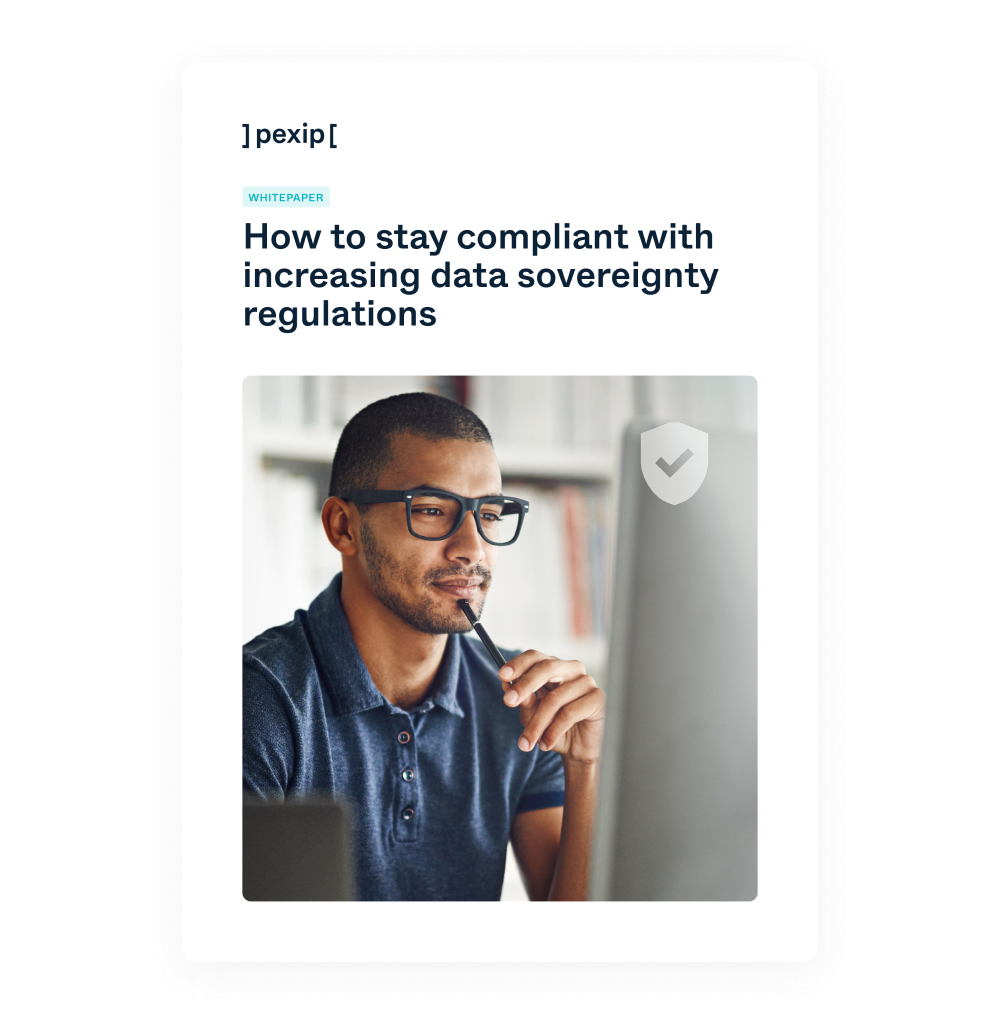The ultimate compliance guide for data sovereignty
A complete guide to the latest regulations around data sovereignty, compliance with regulations, and increasing user adoption.

How to stay compliant with increasing data sovereignty regulations
This whitepaper takes a closer look at the concept of data sovereignty. Data sovereignty refers to all the data generated in an organization subject to the laws and regulations of the country where it is collected. This area is rapidly evolving in today’s regulatory landscape, and organizations must now navigate new and emerging national data privacy and protection regulations.
In this whitepaper, Pexip offers an overview of some of the most essential data regulations in the world today, as well as recommendations and critical considerations to make to achieve compliance.
Jump to section
The data sovereignty turning point: how did we get here?
The turning point for data sovereignty and its subsequent adoption was likely in 2013 when Edward Snowden came onto the global stage. Edward Snowden is responsible for one of the most well-known privacy breaches of the past two decades. This incident is often considered the moment that most of the world’s population realized their conversations and messages weren’t that private.
In the years since Snowden, many high-profile people and organizations have been the victims of data breaches and cyber-attacks, contributing to greater awareness about protecting sensitive data.
With the onset of the war in Ukraine, governments are also acknowledging the importance of data protection to national security. Many nations are seeking ways to reduce the risk of foreign interference or espionage, and this need has only grown in today’s climate of increasing geopolitical tension.
The world has become increasingly digital and interconnected, and nation-states see data sovereignty as a means of ensuring the compliance of those handling data within its borders through tighter regulation of how that data is stored and shared.
New and evolving regulations have emerged to build greater cyber resilience within regions and countries, from NIS2 to the AI Act in the European Union. Both are designed to help organizations manage and reduce risks and protect their data in the age of digitalization and more pervasive AI.
Vital factors driving data sovereignty
Several factors contribute to data sovereignty's increased prominence on the national and corporate agendas. Here is an overview of some key driving factors for organizations today.
Data privacy concerns
With increasing concerns about data privacy and the protection of personal information, many regional organizations seek solutions that allow them to store and process data within their borders rather than relying on third-party providers based in other countries.
Compliance with local regulations
Several data protection regulations in Europe and other regions impose strict requirements on handling personal data. By using sovereign-based collaboration solutions, organizations can ensure that they fully comply with these regulations.
Cybersecurity risks
As cyber threats continue to increase, organizations seek solutions that can help mitigate the risks associated with storing and transmitting sensitive data. Sovereign-based collaboration solutions can address these risks by giving organizations greater control over their data and the ability to secure it within their borders.
Cost savings
For some organizations, a sovereign-based collaboration solution can be more cost-effective than a third-party provider, eliminating the need for data storage and transmission costs.
Competitive advantage
For some organizations, using a sovereign-based collaboration solution can provide a competitive advantage, as it can help them better protect their intellectual property and sensitive business information.
Data protection, privacy, and cybersecurity regulations shaping our digital world
NIS2 Directive
The NIS2 Directive provides EU-wide legislation on cybersecurity and is a response to the growing threats from various types of cyberattacks, ransomware and data breaches. The objective is to create a standard level of cybersecurity across the European Union Member States, harmonizing measures and approaches to establish a more cyber-resilient region.
NIS2, successor to NIS1 from 2016, is a landmark cybersecurity directive that broadens the scope of organizations impacted by it. The updated directive now applies to a wide range of essential and important sectors. Here is the breakdown to determine where you fit in:
- Essential sectors: Energy, health, transport, finance, water supply, digital infrastructure, public administration, space.
- Important sectors: Digital providers, postal services, waste management, food, manufacturing, chemicals, research.
Organizations in essential and important sectors must adhere to several key requirements under NIS2. This is a high-level overview of those requirements:
- Risk management: Implement measures to manage your cybersecurity risks and minimize any impact from potential threats.
- Incident reporting: Report significant threats within 24 hours of detection.
- Supply chain security: Ensure cybersecurity practices are maintained across your supply chain.
- Business continuity: Have plans to maintain and restore essential services during and after a cybersecurity incident.
- Senior management accountability: Top management is responsible for and involved in cybersecurity compliance.
Artificial Intelligence Act
General Data Protection Regulation (GDPR)
ePrivacy Regulation
Health Insurance Portability and Accountability Act (HIPAA)
For organizations operating in the healthcare sector, HIPAA sets out strict rules for protecting personal health information (PHI), including requirements for the secure transmission of PHI over video collaboration platforms.
NCSC 14
CLOUD Act
Key considerations to stay compliant
Data protection and privacy
Ensure that all data being shared is protected and kept confidential, following any relevant regulations such as GDPR or HIPAA. This means implementing proper access controls, encryption, and audit trails to protect sensitive information.
User authentication and authorization
Make sure that only authorized users have access to the information being shared. This can be achieved through implementing robust authentication mechanisms, such as multi-factor authentication, and by carefully managing access permissions.
Device security
Ensure that all devices used for collaboration are secure and updated with the latest security patches. This includes laptops, smartphones, and other devices that may be used to access sensitive information.
Network security
Ensure that all communication channels are secure and protected from hacking, eavesdropping, and other forms of tampering. This can be achieved using secure protocols, such as SSL/TLS, and by implementing firewalls, intrusion detection systems, and other security controls.
Continuous monitoring and audit
Monitor and audit the collaboration platform and systems regularly to ensure that they operate securely and comply with relevant regulations. This will help identify security incidents and vulnerabilities, allowing them to be addressed before they can be exploited by malicious actors.
Vital factors driving data sovereignty trend
Data privacy concerns
Compliance with local regulations
Cybersecurity risks
Cost savings
Competitive advantage
What are the consequences of
non-compliance?
Non-compliance with data protection-related regulations can result in various risks and consequences for organizations. These risks may
vary depending on the specific rules in place and the severity of the violation. Here are some of the more common risks:
- Fines: In some nations, regulatory authorities impose penalties for improper data storage and sharing. In the EU, a lack of compliance with NIS2 regarding proper risk management and incident reporting can lead to significant fines, as much as 2% of an organization's annual revenue.
- Personal liability: To ensure that top management takes an active role in managing their organizations' cyber resilience, NIS2 in the EU holds top leaders personally liable in the event of a breach or cyber-attack if they have not taken appropriate measures to protect the organization.
- Reputation damage: Non-compliance can make organizations more vulnerable to a data breach, which can erode the trust of customers, partners, and other stakeholders.
- Loss of business opportunities: Failure to comply with data regulation can lead to restricted market access, meaning a failure to do business within certain national borders.
- Security risks: Without proper protections in place, in line with regulation, organizations increase their vulnerability, which may lead to unauthorized access to their data and the potential exposure of sensitive information.
- Legal action: When data is mishandled, it is subject to legal action by the company or individual whose data was mishandled. This can lead to lengthy processes, high fees, and a reputational loss.
What evolving regulations mean for video conferencing
Compliant solutions
Compliant solutions

Greater data control
Greater data control

Business continuity enabler
Business continuity enabler

Download the guide to continue reading
Download the full version of the data sovereignty compliance guide and access the free checklist for choosing a secure video meeting solution.
